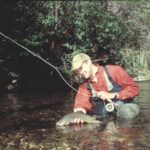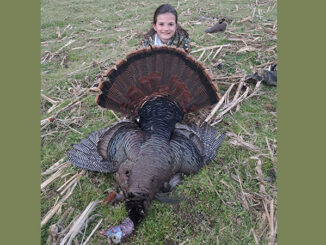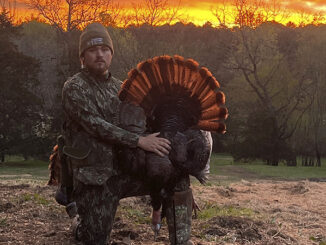
N.C.’s most-popular trout stream has many faces, with stretches that are crowded, but anglers can find solitude and big fish by searching diligently.
Ask any dedicated North Carolina fly fisherman about the Davidson River, and you’re likely to get a strongly opinionated reply.
That response might include that the Davidson is the premier and best-known trout stream in the state. It consistently ranks among the top trout water in the region and also was listed in Trout Unlimited’s book, “America’s 100 Best Trout Streams.”
On the other hand, you might hear about the Davidson’s infamously difficult-to-catch trout or equally maddening weekend crowds. It’s all a part of the Davidson River experience.
The fish are big but educated, selective and wary. The spring insect hatches can be prolific and luxuriant, but so are the accompanying “Gore-Tex hatches.”
Those who love the river learn to accept the pluses and minuses, but the sum cleanly lands in positive territory.
There is little disagreement among trout anglers that the Davidson presents one of the stiffest challenges for N.C. fly-rod enthusiasts.
According to Kevin Howell, owner of Davidson River Outfitters in Pisgah Forest, the Davidson’s trout are some of the most difficult fish to catch in the world.
“Once an angler can successfully catch fish on a repeated basis out of the Davidson, they are capable of catching fish out of any river in the world,” said Howell.
Yes, it can be that tough.
During its journey from the N.C. high country to the confluence with the French Broad River near Brevard, the Davidson River reshapes itself into different personalities and moods.
The river upstream of the Pisgah State Fish Hatchery has all the characteristics of any typical mountain trout stream found throughout the Southern Appalachians. As it carves its way through rugged mountain terrain, it hosts a healthy population of wild brown and rainbow trout in a pristine setting.
“The Upper Davidson from the Pisgah Hatchery upriver to its headwaters is classic mountain pocket water,” Howell said. “The fish average 10 to 13 inches with a few larger ones mixed for good measure.”
The water is relatively infertile and fish have to be opportunistic feeders to survive. Any well-presented fly has a good chance of hooking up with a colorful, wild trout.
Anglers are much more likely to have plenty of river to fish in this stretch as the river takes on the look and feel of real wilderness.
In contrast, the area near the hatchery is the most-crowded and challenging stretch of the entire river. The fish are bigger, more educated from seeing fishermen on a regular basis and not so easily fooled. If an angler wants to stake out a piece of river here to fish, the best bet is a visit during a weekday when there are far fewer people thrashing the water.
“This section of river, from the diversion weir to about a half-mile below the hatchery, receives 90 percent of the fishing pressure the Davidson River receives,” Howell said. “It can get very crowded at times.”
A significant amount of water is diverted from the river through the hatchery, so anglers often see many large trout cruising confidently in the shallow, reduced river flow. From the infamous “Desperation Pool” behind the hatchery, scores of rainbow and brown trout in excess of 18 inches can be spied in plain view from the river’s bank. Not only does this contribute to a state of neurosis with well-outfitted pursuers, it gives a decided edge to the quarry.
“The nutrients the hatchery pumps back into the river, such as excess trout food, chronimid worms and general waste products, have caused the fish in this section to reach much larger sizes,” Howell said. “The average fish in this section runs 16 to 18 inches, but there are a lot of trout over 20 inches.”
This fishing is technical at this stretch of the Davidson, and most beginner or novice fly anglers leave the river frustrated by failed attempts at hooking these fish.
“What is required to catch these trout is a technical, completely drag-free drift with a fly that the fish don’t get hammered with every day,” Howell said.
“Although anglers occasionally will catch some fish with midges or will wait for a flush from the hatchery before fishing eggs or pellet patterns, the anglers who are highly successful in this section have learned to think outside of the box.
“For example, while most anglers prefer to go with smaller flies — sizes 20 to 30 — I like to go with much larger flies, size 8 or bigger, because no one else is fishing anything that big. Often enough, it’s made all the difference.”
If an angler takes a short walk downstream from the hatchery, he’ll soon lose the crowds, but the fishing still can be phenomenal. Although a popular stretch of river during weekends, anglers will find significantly more elbow room from the hatchery downstream to the Avery Creek tributary.
“This section has a pool-and-riffle sequence that’s typical of any freestone stream,” Howell said. “There are some very big trout through here, some as large as 30 inches. Most of the fish in this area, however, average 13 to 16 inches.”
From the Davidson’s headwaters downstream to Avery Creek, the water is classified as Catch-and Release/Artificial Flies Only by the N.C. Wildlife Resources Commission. No fish may be harvested or possessed at any time and only artificial flies with a single hook can be used for fishing.
From Avery Creek downstream to the National Forest boundary, the river is heavily stocked and popular with bait and spin fishermen, especially during spring and early summer.
According to Powell Wheeler, the WRC’s District 9 fisheries biologist, this section of river gets a heavy dose of stocking because of its accessibility and proximity to towns like Asheville and Brevard.
“The Davidson River is one of our state’s premier hatchery-supported streams, due to its superior water quality and its relative ease in accessibility,” Wheeler said. “We stock 1 mile of the Davidson River from Avery Creek downstream to the National Forest boundary. From March through July, we stock 16,500 trout into the Davidson each year. Those fish are about 40 percent brook trout, 40 percent rainbows, and 20 percent browns.”
General trout regulations apply to this stretch of the Davidson. There is neither a minimum size limit nor any lure or bait restrictions and the daily creel limit is seven fish. This hatchery-supported section is open for fishing year-round except during the month of March, when it’s closed for all fishing.
Just below the town of Pisgah Forest, Davidson River Outfitters manages a 3-mile stretch of private trophy trout water.
“This section is characterized by long, slow-moving slicks and gradual riffles,” Howell said. “It doesn’t get the fishing pressure that the river receives upstream, due to our limiting access here.
“It fishes best with small flies, light tippets, and long, accurate casts. The trout in this section average 20 to 22 inches, but fish that are 25 inches and better are not uncommon.”
Fly fishermen in North Carolina consider the Davidson to be one of the best rivers in the state for reliable insect hatches. Naturally, spring is the time of year to indulge in some great dry-fly action when the bugs are on the move.
“The Davidson does have some good spring hatches,” said Howell. “In the spring, anglers can expect to find both Light and Dark Hendricksons, Quill Gordons, Yellow Sallies, yellow and tan Caddis, as well as Green Drakes,” Howell said. “Crane flies are also present in good quantities.”
The dates highlighted on a traditional dry-fly fisherman’s calendar include the Hendrickson hatch during mid-April and the Green Drakes the last two weeks of May. Aside from some of the big tailwaters, this is an angler’s best chance in the southern United States to catch a 20-inch trout by using a dry fly.
In late spring and early summer when the aquatic insect hatches begin to wane, trout begin to key on terrestrial insects. Ants, beetles, and small green inchworms work particularly well.
“In late spring through summer, inchworms are everywhere,” Howell said.
In order to consistently catch the Davidson’s tough trout, an angler needs to work hard and be flexible — changing techniques and flies to match the current conditions.
“Anglers should plan on fishing some long days while using a mix of different patterns,” Howell said. “In the mornings, nymphs such as the Sheepfly, Kevin’s Stonefly, and the Red Fox Squirrel nymph will produce some nice fish pretty regularly.”
As is usually the case, these nymphs should be fished near or on the stream bottom. If anglers aren’t hanging up every once in a while, they’re probably not fishing deep enough.
The Davidson River has exceptionally clear water, so wading close to feeding fish is difficult. For that reason, fishing nymphs using longer casts and a strike indicator is recommended. During sunny days, anglers should fish from the shaded areas of the river to help mask their presence.
In addition to those nymphs already listed, Howell recommended Pheasant Tails, Gold-Ribbed Hares Ears, and Brassies in a variety of sizes.
“For anglers who prefer to fish dries, I wouldn’t get to the river until at least 5 p.m. and fish until dark,” he said. “This is particularly true in late spring and early summer. The dry-fly fishing gets progressively better throughout the evening until dark.”
Howell highly recommended Caddis Patterns in tan or Yellow, Yellow Sally Patterns, Adams for dark mayfly hatches, and Cahills and Hendricksons for the light-colored mayfly hatches.
He also said fly anglers should carry a variety of streamers when they visit the Davidson.
“Always carry some large black or olive streamers for rainy days or for immediately after a spring thunderstorm,” Howell said. “That’s when the large trout are caught.”
If you arrive on a picture-perfect spring day and the Davidson is too crowded, don’t overlook one of the nearby tributaries. Looking Glass and Avery Creek are excellent fly-fishing options when the Davidson is crowded or too warm during the summer.
They’re far more likely to provide a day of relative solitude as well.
As spring gives way to summer, the fishing becomes much tougher as the water levels are lower, the water temperatures rise, and tubers and swimmers take to the river en masse.
Fishing early morning or late in the evening is the best bet at this time.
The fishing improves again during the fall when water temperatures begin to drop and the trout’s feeding activity picks up again. Late-season insects hatches offer a second season for dry-fly enthusiasts.
Winter can be exceptionally good, especially those occasional mild days. Late fall and winter offer some of the best shots for tangling with one of the Davidson’s legendary lunker trout. Big browns are then on the move and become aggressive during the spawning season.
Don’t let the Davidson’s tough reputation keep you away from this classic trout river. With some hard work and a little patience, the Davidson can offer one of the best fly-fishing experiences of your life.









Be the first to comment